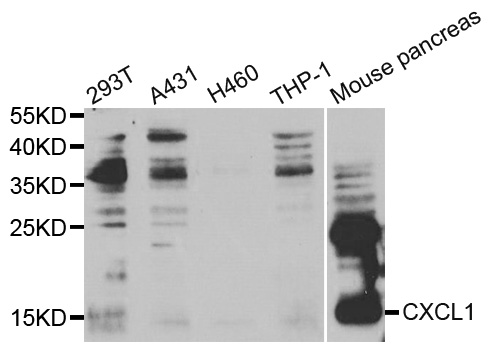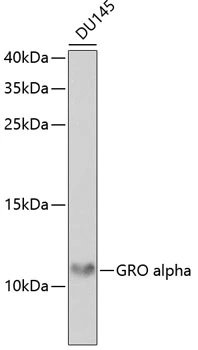CXCL1 / GRO alpha antibody
GTX14026
ApplicationsWestern Blot, ELISA
Product group Antibodies
TargetCXCL1
Overview
- SupplierGeneTex
- Product NameCXCL1 / GRO alpha antibody
- Delivery Days Customer9
- Application Supplier NoteWB: 1:500. *Optimal dilutions/concentrations should be determined by the researcher.Not tested in other applications.
- ApplicationsWestern Blot, ELISA
- CertificationResearch Use Only
- ClonalityPolyclonal
- ConjugateUnconjugated
- Gene ID2919
- Target nameCXCL1
- Target descriptionC-X-C motif chemokine ligand 1
- Target synonymsFSP, GRO1, GROa, MGSA, MGSA-a, NAP-3, SCYB1, growth-regulated alpha protein, C-X-C motif chemokine 1, GRO-alpha(1-73), GRO1 oncogene (melanoma growth stimulating activity, alpha), GRO1 oncogene (melanoma growth-stimulating activity), MGSA alpha, chemokine (C-X-C motif) ligand 1 (melanoma growth stimulating activity, alpha), fibroblast secretory protein, melanoma growth stimulating activity, alpha, melanoma growth stimulatory activity alpha, neutrophil-activating protein 3
- HostChicken
- IsotypeIgY
- Protein IDP09341
- Protein NameGrowth-regulated alpha protein
- Scientific DescriptionThe GRO gene was originally identified by subtractive hybridization studies between normal and tumorigenic Chinese hamster embryo fibroblasts. The hamster cDNA was cloned and used as a probe for cloning of the human GRO cDNA. The GROalpha gene initially cloned from T24 cells and the gene in melanoma cells encoding melanoma growth stimulating protein (MGSA) are identical. Human cells contain three closely related, but distinct GRO genes: GRO alpha, GRO beta, and GRO gamma. GRO beta and GRO gamma share 93% and 82% identity, respectively, with GRO alpha at the nucleotide level. GROs are members of the chemokine alpha family that is characterized by the separation with one amino acid of the first two cysteine residues, C-X-C, in the amino acid sequence. The GRO gene has been mapped to chromosome 4q21. In normal cells, human mRNA GRO expression is found in foreskin fibroblasts, synovial fibroblasts, chondrocytes and osteocytes. Additionally, GRO mRNA has been detected in mammary fibroblasts, mammary epithelial cells, endothelial cells, activated monocytes, macrophages, and neutrophils. Characterization of the GROalpha receptor indicates the presence of low and high affinity receptors on human neutrophils.
- Storage Instruction-20°C or -80°C,2°C to 8°C
- UNSPSC12352203




